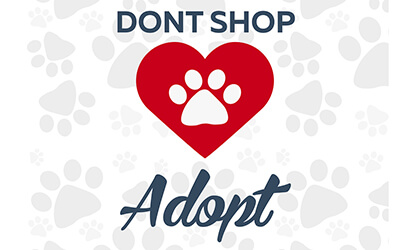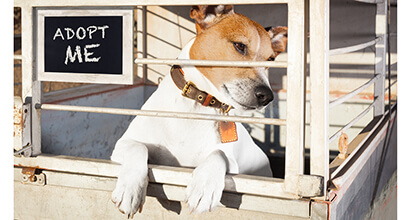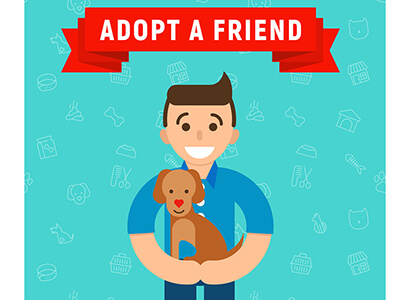
Benefits of Adopting a Pet from an Animal Shelter
Are you considering whether or not to adopt an animal from a breeder or pet store, or to adopt one from a shelter? Adopting your pet from a shelter is a great alternative to spending a lot of money going through a breeder or a pet store. People tend to have a negative idea about getting a pet from a shelter, but most of these ideas stem from myths that have no basis in reality at all.
Shelter dogs and cats have a number of benefits besides just being a great companion; often they are better trained and have been vaccinated before they even walk out the door with you. Breeders and puppy-mill born pet shop animals often don’t come with such benefits and typically have health problems because of this.
Still on the fence about getting a shelter animal? Why not go ahead and check out this list of reasons why adopting a shelter pet can do far more than add a furry little friend to your home. Adopting can save the life of a cat or dog, and who knows–your new pet may even save yours. Read on to learn more.
Pets can help you enjoy a more active lifestyle

With a pet, it is important that you are taking good care of them, but did you know that pets can also take care of their owners? Pets can provide emotional, physical, and mental health benefits. Since pets, especially dogs, require a lot of attention and need to go outside every couple of hours, pet owners are forced to get up and move around. Reported by the Center for Disease Control and Prevention, owning a pet has been shown to help lower a person’s cholesterol, blood pressure, and loneliness. Not only do pets give love unconditionally, they are able to give their owners a sense of fulfillment and purpose. When you adopt, you can also be proud that you are giving your pets the help that they need.
You will be saving a life.
Every single year, up to eight million dogs sit in shelters waiting to be adopted. The number is so high that millions of these dogs end up being euthanized every year due to the shelters being over-crowded. When you take home a new pet, you are also making more room at the shelter for another pet who has nowhere to call home. Adopting a shelter animal will not only give your pet a new lease on life, it may literally save their life. You can give them a loving home so they no longer spend lonely nights in a cage.
Adopting helps reduce puppy mills

While they are adorable, the little puppies often found in pet stores come from puppy mills where they are forced to live in overcrowded and unsanitary environments. These mills run like a factory and care more about making money than about caring for the dogs and puppies. The mothers of these pups are often deprived of human interaction and kept in cages where they are bred over and over again until their bodies are worn out. Then sadly, they are either killed or abandoned without ever knowing a loving home.
The director of research and outreach for the Puppy Mills Campaign, Kathleen Summers, says that even just going to look at puppies at a pet store can support the puppy mill world. This is because pet stores work to separate the buyer from the harsh reality of the origin of these puppies.
There has been a reduction in the euthanizing of healthy pets in the country, but those who choose to buy pets from stores instead of adopting them could end up turning back time to when America put down more adoptable dogs than it does currently.
Most shelter animals are already house broken.

One of the biggest myths surrounding a shelter pet is that they all have been rescued from abuse and/or have behavioral issues. Most shelter animals end up there because their owners are no longer able to take care of them. They are there due to people issues, like a loss of income, divorce, lack of housing where pets are allowed, or lack of access to a vet. Many of these animals, especially senior animals, are often already socialized and house broken. The goal of these rescues and shelters is to get pets into happy homes, and they employ training for basic commands, house training, and social skills because of it.
Shelter animals are usually in better health than animals bought somewhere else.
Animals go through full physical exams when they come into a shelter. Many shelters will even have vet clinics to treat any medical problems that come about. Shelter facilities also ensure that animals are in the best possible shape before putting them up for adoption.
A lot of pet stores and even some breeders don’t give animals the same medical services before putting them up for adoption. This means that puppies from mills that are sold at pet stores can have diseases that range from pneumonia to parasites, as reported by the American Society for the Prevention of Cruelty to Animals.
It is often cheaper to adopt than it is to buy from a breeder

The cost of adopting an animal from a shelter will typically be much less than buying one from a breeder. It depends on the age of the animal, but buying from a breeder often costs anywhere from a couple hundred dollars to a thousand dollars. Even after paying this price, you often aren’t getting any health benefits. Most shelters will neuter and spay their animals before putting them up for adoption, which can save you money. Rescue animals are also often vaccinated and microchipped, and those services can run as high as $60 and $150, respectively. You may potentially even save money by getting a dog that has already been trained by a professional.
While adoption fees can sometimes still be hundreds of dollars, vet costs, which can add up swiftly, are not included. Shelters all over will typically discount adoptions and waive fees altogether during special events.
You can save an adult animal.
Adult or senior animals are often overlooked because people romanticize the idea of having a puppy. With an older dog, you are typically already getting a house broken animal, and some even understand basic commands. This includes things like "sit," "stay," and "lay down." Not only will this make your life easier, you won’t have to spend money on paying for a trainer to make your dog obedient.
You also will get to avoid the puppy phase, as it is called. Less of that energy means less biting, clawing, chewing, and more that can damage your property. You can see the personality that the adult animal has developed instead of waiting to see what you’ll get from a puppy.
You will have shelter employees as a valuable resource.
Shelter employees are great sources of information for your dog questions. Because you saved a life, they will be more than happy to provide you with resources. This could include things like reputable trainers, and the best vet in town that helps patients at the lowest prices but provides the best of care.

You will get an animal that has been well cared for.
All animals that go through a good shelter are handled by experienced staff. Pets are given vaccinations as soon as they arrive. They also go through a behavioral screening processes. Sometimes, these shelters will include clinics or have vets come in to check on the animals to ensure that they are healthy.
You will be supporting a charity.
It is a sad truth that every community in America has an animal shelter. When you adopt from shelters, you are often assisting a non-profit organization that benefits animals. You are also sending a message about adoption to those who ask where you got your pet from. Animal shelters also spay and neuter their animals, as mentioned above, which helps prevent unwanted animals from being born and perpetuating the problem.
You can enhance your sense of responsibility.
Owning a pet is a fun experience that comes with a lot of responsibility. While it is fun, it isn’t for everyone. So, know that when you are purchasing a pet, you are also taking on a new addition to your routine and will be spending more money for its ongoing care. You could also choose to be a foster parent to learn if a pet is going to be well suited for your home and your schedule; you can use a foster pet to decide if you’re ready for the long-term commitment.
It doesn’t matter if you own a house or rent a house.
If you own your own home and are ready to adopt an animal, ask your insurance provider to see if they have any restrictions, such as particular dog breeds. You don’t want to get a dog only to find out they aren’t covered. In most other instances you’ll be fine. You can live in a pet-friendly apartment and bring one home just as easily.

You can get a pet to suit any need.
Allergies are a common reason that families will drop off a pet at a pound or shelter. If you and your family want a pet but a family member has allergies, you could always look into getting a dog or a cat that is hypo-allergenic so that you can still share all of your love with a pet without any issues with allergic reactions.
You can find a pet that is kid friendly so the whole family is happy.
Dogs and cats behave differently around children than they do around adults. Not every pet is going to be good for a home with children. If your dog or cat will be interacting with children, socializing them is imperative. If you don’t have kids in the home currently, consider whether or not you will in the future. This includes nieces, nephews, neighborhood kids, grandkids, and other children. You’ll need to take the necessary steps to be sure that your pet is prepared to be around children.
Either choose a dog that has been rescued and has a good history of interacting with children, or get a pet that can be trained to be friendly.
Pets are worth the money.
Of course, when making a responsible decision about purchasing a pet, you will need to take into consideration the costs that will come with owning a pet. Your dog and cat will need a carrier or a crate. They will also need a bed, food and water bowls, a collar, food, toys, and more.
You also need to have your pet legally licensed inside of the city. Training classes are another expense to consider if you are adopting a dog. Another important thing to remember is that dogs and cats can live as long as 15 to 20 years, meaning that you will be providing regular medical care and emergency medical care, just like you would for humans. Animals can get sick at any time as well, and you must be prepared to spend money spontaneously that you did not plan to spend. While they are expensive, they give so much love, support, and happiness that they are truly worth every penny.
Getting a mixed breed from a shelter costs less money.
A mixed breed animal is more likely to live longer. This is because they have fewer health issues typically than over-bred pure breed dogs. Many of these pure breed animals are more prone to getting health problems like hip dysplasia, breathing difficulties, or even an enlarged heart. Having a mixed breed dog will help save you a lot of money on vet bills.
Pet Adoption FAQs

So, you’ve decided adopting a pet is the right choice for you and your family. If you have never adopted a pet before, you might be wondering how everything works. Maybe you want to know how long it takes to adopt one or how much it costs? Each organization is different but understanding the basic process will make things run more smoothly. Below, we will show you how the adoption process works so that you can be prepared for what comes next.
Adopting from a Shelter.
Shelters are often run by the county or city. These can include police and health departments, animal control, dog wardens, and can sometimes be called the "pound." There are even private shelters that consider themselves part of the "SPCA" or the "humane society," but they are all independently run organizations and government offices. Just because they share a name doesn’t mean that it is all the same organization.
Shelters will have an actual facility with operating hours that employs staff members. Some will have adoption events run by volunteers. If you see a pet online and want to go visit the shelter to see them in person, you can. Shelters are often understaffed and can’t always answer emails or phone calls.
The adoption process is different for every shelter. A shelter adoption could go like this:
- Find a pet that you want by going online or visiting the shelter itself.
- You pick out your pet and go see it. You will then ask the shelter desk staff if they can take the pet out so that you can meet them.
- You decide you want the pet and you go to the desk to give them your ID, pay the adoption cost, and get copies of the pet’s sterilization, vaccination, or medical records so that you can get the pet licensed.
- Take the pet home!
Adopting a Pet from a Rescue.

Rescues will often have their adoption-ready pets in foster homes or private boarding locations. These are run by volunteers more often than not. They may even have adoption events at different places like a pet store. Read the instructions about the rescue and the adoption process. Follow their specific instructions. Some may prefer that you email them first, but others want you to fill out your application first so they can better answer any questions you may have. You must be patient when adopting from a rescue, or when waiting for a response to an email or a phone call as they are often volunteers, and like everywhere else, are probably short on help.
The adoption process for rescue animals is a little different:
- Find a pet at a rescue online or by visiting the facility.
- Email the rescue or fill out their application.
- When the volunteer calls and you find out more about the pet, you can decide if the pet sounds like a good match.
- You go into the rescue to meet the pet.
Each rescue’s adoption process is different. Here’s one example of how a rescue adoption might work:
- You meet the pet and want to take them home. A home check volunteer does a home visit. Once you pass the visit, you will be able to adopt the pet.
- You receive the copies of sterilization and vaccination records.
- You arrange a delivery day for the pet to arrive.
- Your pet is brought to your home by a volunteer. All you have to do is sign the contract and pay the fee.
Shelter versus Rescue Adoption

The advantages of adopting from a shelter include the fact that you can see the different pets that are up for adoption at the same time. Many shelters will have a simple screening process or no screening process at all. They will let you take home the pet that you want that same day if everything works out. Adoption fees will be lower than a rescue, but they may need more vet care after you adopt them especially since they have been in foster homes.
How Can I Tell if a Rescue Group Is a Scam or Real?
There are some things to watch out for. Not one aspect alone will show whether or not a rescue is legitimate. If you see one or more of the warning signs below, you may want to look for a pet somewhere else.
- Does the group list only or mainly "designer" puppies?
- Is the organization answering your questions?
- Are you comfortable speaking with them?
- What comes included in the adoption fee?
- Is the group asking YOU questions?
Finding the right people to adopt from isn’t what could be considered a science, so really, it’s best to trust your own judgment.
If you contact the adoption group, will it put the pet on hold?
Submitting an adoption application or inquiry won’t guarantee that you are getting the pet you applied for, and it certainly does not put this pet on hold for you. Contact the shelter or rescue group to get more information on this.
How long does it take to hear from the group I am adopting from?
When you visit an animal shelter, someone will ideally greet you the second you come in the door. They will then escort you to meet the different pets while also answering your questions. Sometimes, however, the person at the desk is busy on a phone call and the reception office has their hands full with a box of kittens. Also, you might send in an application to a location and get a response in a matter of minutes, while other places can take a day or a week to reply. Don’t hesitate to follow up with the shelter. They are busy people.

What are the requirements for pet adoption?
Each adoption group is going to have its own requirements, qualifications, and rules to adopt pets. The group’s terms and policies, including requirements and rules regarding out of state adoptions, are set by each individual group. To find out what these policies are, you need contact the adoption organization that has the pet you want. Bring someone who may also be interested in adopting a pet. You can both become more informed regarding decisions that need to be made when adopting a pet.
Is there going to be an adoption fee?
Every adoption group will have its own rules concerning pet adoption. Adoption fees will often need to be sorted out with the company themselves.
Why do these places choose to charge an adoption fee in the first place?
Adoption fees help to keep the place running. They cover the medical care of the animal while they are waiting to be adopted. These fees also cover transportation and food costs. Adoption fees allow the pet and the other animals to get a much higher level of care in the rescue or shelter, especially for those who have bills higher than an adoption fee. This money also serves as a donation to support the entire organization. Depending on where you are adopting the animal from, adoption fees and procedures include different things. Fees can range from $0 to several hundred dollars.
What does an adoption fee cover?
In the grand scheme of things, an adoption fee could actually end up saving you money. These adoption fees are often used by shelters and rescues to cover those initial costs at the vet in order to prepare the animal for his or her new home. Adoption fees often include:
- Flea/tick treatment which is between $50 to $200
- Deworming which is between $20 to $50
- Veterinary wellness visit $50 to $100
- Distemper vaccination which is between $20 to $30
- Feline Leukemia test for cats which is between $30 to $50
- Heartworm test for dogs which is between $15 to $35
- Microchip that costs $50
- Spaying or neutering which is between $150 to $300
- Rabies vaccination which is between $15 to $25
- Collar and an identification tag which is between $5 to $10
The total that you are looking at is an impressive $425 to $800, which is much less than some vet visits can cost. Few shelters or even rescues will chargethis much for an adoption fee. Those that are free offer no medical care. You’ll save initially on the adoption fee, but the medical costs will quickly add up. Pets that don’t come with a fee will often not have been spayed or neutered or have not been fully vaccinated which can cost you more money as well.
5 Unfortunate Myths about Shelter Pets
Myth: Shelter pets aren’t healthy.

Fact: Shelter pets are usually much more healthy than the ones that can be purchased from a pet store. When a pet goes into a shelter, they are instantly given their vaccinations. Shelters often have vets on site or vets who come in and help sick animals to get them healthy before they are adopted.
When you purchase a puppy mill dog from a pet store, more often than not, the pet has not been living in the best conditions. This means they usually aren’t vaccinated, they haven’t been seen by a vet, except for perhaps a single time, and they have almost definitely not been spayed or neutered. In fact, Dr. Jules Benson, the VP of Veterinary Services at Petplan Pet Insurance, states that pets that come from rescue groups or shelters are 5 percent less likely to need an unexpected trip to see the vet than their pet-store counterparts.
Myth: I won’t be able to find the pure bred dog that I dream about at a shelter.
Fact: There are a number of different dogs at shelters, from mutts to purebreds alike. People often buy their purebreds from breeders and end up having to give away the dogs for a variety of reasons. Purebreds can also come in off of the street, just like any other dog. According to some studies, purebred dogs are actually around 25 percent of the dogs in any given shelter.
Myth: Shelter pets misbehave and are unruly.
Fact: This is simply not true. Most shelter pets go through extensive socialization and training techniques before being put up for adoption. This is done in order to make the transition to their new home simpler and to make life easier on the adoptive parent.

Myth: I won’t get to know my pet before I bring them back to my house.
Fact: Most shelters offer not only online pet profiles that describe their personalities, but you can schedule visits with the pet. This will allow you to spend time getting to know the animal before you make the decision to bring them back to your home.
Myth: All of the pets in a shelter will be senior animals.
Fact: Most of these shelters and rescues will have a variety of pets of all ages, including older pets and puppies alike. These are often better trained and will require less work. You can get a puppy through a shelter, but getting an older dog definitely has its perks. You will be giving the dog a new lease on life and getting a great companion who is well trained and ready for a new life with a new family.
